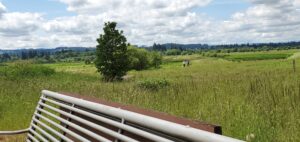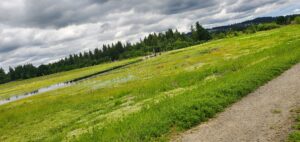
Tualitin Wildlife Refuge
By Ines Garcia Fullana
Summers in Oregon are the best time of year to explore the state’s hidden gems and explore its beauty. For years, I have been hearing great stories from everyone around me about Oregon treasures.
Hearing everyone’s adventurous stories without personally experiencing them made it clear that I was missing out. Because of my love of nature and a strong desire to explore, I felt motivated to seek new adventures. Additionally, facing challenges and staying active in my wheelchair pushed me further. As a result, I now pursue what has become my yearly summer solo adventures.

Three years ago, I decided to scout out ADA trails that were accessible via Trimet. Despite everyone’s recommendations for specific ADA trails and their suggestions that I could only explore with a car, I chose to take a different path. I was determined to prove the opposite—and I did. Along the way, I encountered some challenges; however, they didn’t stop me from discovering some great ADA trails. In particular, I enjoyed the Tualatin Wildlife Refuge. As I made my way around the trail, I experienced three different types of habitats, each filled with diverse wildlife, which made it a truly unique place.
Tualatin River National Wildlife Refuge
Tualatin River National Wildlife Refuge Seasonal Trail Loop is a 3.1-mile trail located in Sherwood. To begin your visit, the Wildlife Center—open Tuesday through Sunday from 10:00 a.m. to 4:00 p.m.—serves as a great starting point. Additionally, the best times to explore the trail are during fall and spring, when mild weather and active wildlife create ideal conditions. In fact, nearly 200 species of birds, over 50 species of mammals, and about 25 species of reptiles and amphibians call the refuge home. As a result, visitors experience a rich and diverse ecosystem that offers something new with every trip.
Directions To The Trail
You can reach the trail either by car or by bus. If you drive, there’s a paved parking lot with direct access to the trail. Alternatively, taking the bus drops you off at a paved stop, where you’ll find open meadows and a detailed trail map. Regardless of how you arrive, amenities are available to enhance your visit. For example, you’ll find ADA-accessible restrooms, picnic tables, a children’s play area, and a gift shop. In addition, there’s a paved viewpoint that offers a panoramic view of the trail. From this spot, you can enjoy the surrounding flora, fauna, and the peaceful variety of habitats the refuge has to offer.
From The Bus Stop
At the bus stop, there is direct access to the trail. To begin, the path is easy and flat, running through open fields that lead to the wetlands. Initially, it starts with a short section of loose gravel; however, it quickly alternates between compacted gravel and dirt. Alternatively, the second entrance is mostly compacted gravel and includes a short, moderately steep hill. At the top of this hill, you’ll find a bench at the Centennial Overlook, shaded by large oak trees. Notably, this spot offers one of the best chances to see waterbirds in the area.
After taking in the view, you can continue along the flat trail, which will then lead you directly to the Wildlife Center. Once there, the center offers educational programs for both kids and adults. Inside, you’ll find an exhibit hall, a classroom, and a photo gallery with displays on the center’s history and local environmental topics. Additionally, outside the center, there’s an education shelter and a nature store. Notably, the store features souvenirs and crafts made by local artisans, giving visitors a chance to support the community. Whether you’re visiting for learning or leisure, the Wildlife Center serves as a meaningful and enjoyable stop along the trail.

From The Wildlife Center
From the Wildlife Center, the trail begins next to the picnic area. Just around the corner, you’ll find the accessible entrance. At first, the trail starts with a moderate downhill slope; however, it soon levels out into flat terrain for the rest of the way. The path is easy to navigate and alternates between compacted dirt and gravel. Along the way, several paved viewing points appear, offering excellent chances to spot wildlife such as beavers, deer, and many types of birds. As you continue, the trail leads into a more wooded area surrounded by trees. In this section, you’ll discover quiet spots with views of small creeks, peaceful ponds, and a variety of native plants.
Eventually, the wooded section opens up to a large circular paved viewing point. From this spot, you get sweeping views of the meadows. After taking in the scenery, you can either return the way you came or, alternatively, follow the trail to the left, which leads through the wetlands. This area is ideal for spotting even more wildlife and soaking in the natural beauty. Whether you’re a bird watcher, a photographer, or simply someone seeking a peaceful hike, the refuge provides a refreshing break from the city. Overall, it’s a great place to enjoy nature and experience the diversity of the habitat.


